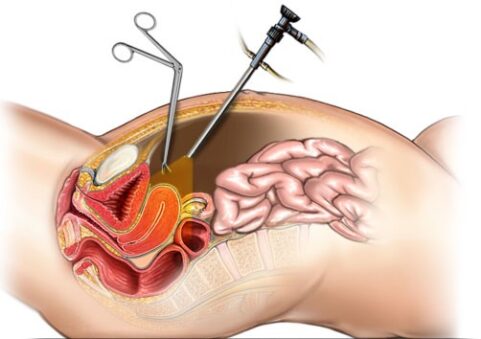Lap. & Endo. Gynaecologist & Cancer Surgeon
Smt. Motiben B. Dalvi Hospital have the best team that provides expert medical care to women with any gynaecological problems. We are one of the best hospitals for women’s health in Mumbai, and it is our responsibility to provide a caring and safe environment for our patients. Having the best gynaecologists in Mumbai, we offer a comprehensive range of treatments to all the women for their gynaecologic issues as we are known to be amongst the best hospital for the treatment of gynaecological issues in South Mumbai.
Endoscopy
Is the direct observation of an organ or cavity by inserting an endoscope through natural orifices or small incisions. Endoscopy allows obtaining a more reliable and accurate information compared to other techniques. Gynaecology Endoscopy is a surgical discipline that is specially designed to see & treat the most frequently occurring female disorders and pathologies. It is state of the art investigation for evaluation and management of female infertility viz., assessment of tubal status, cysts, endometrioma, chronic pelvic infection, and adhesions. Intrauterine polyp, submucous fibroids, septum of uterus can be managed easily by hysteroscopy as day care procedure. Similarly, ectopic pregnancies can easily be handled by Gynaecology Endoscopy as day care procedure. The Gynaecology Endoscopy uses optical instruments and employs hysteroscopy and laparoscopy for these purposes. Technical advances, coupled with sophistication and miniaturization of the equipment have made Gynaecology Endoscopy a possibility now-a-days. Moreover, the modern anaesthetic medicine has also played a significant role in developing these surgical procedures.
What are the uses of Gynaecology Endoscopic Surgery?
The endoscopic surgery makes it possible to treat most of the gynaecological pathologies as day care procedure avoiding major operations requiring prolonged hospitalization. It is useful in tubal recanalization, endometrioma operation, dermoid operation, myomectomy, total laparoscopic hysterectomy, ectopic pregnancy management, searching for pelvic pathologies causing infertility and recurrent abortions.
Hysteroscopy helps in discerning between: endometrial alterations (atrophies or hyperplasia); endometrial adhesion; myomas (benign tumours); endometrial polyps; and uterine septa or malformations.
Through the Gynaecological Endoscopic Surgery, the need for a major operation in cases of endometriosis and ovarian tumours is prevented. Moreover, the Gynaecological Endoscopic Surgery is the fastest way of carrying out tubal ligation. It is also effective for diagnosing causes of infertility.
What are the advantages of Gynaecology Endoscopic Surgery?
- Faster recovery compared to classical surgery cases.
- Post-operational infections are less probable to occur compared to conventional surgery.
It is worth mentioning here that these modern surgical techniques are meticulous, while the anaesthetic procedures allow for a fast recovery. The side-effects are almost non-existent.
Types of Endoscopic Surgeries
- Laparoscopy – With the advances in technology, laparoscopic surgery is rapidly and progressively replacing conventional surgery except for the most difficult cases. Diagnostic laparoscopy is an invaluable tool for assessing patients with chronic pelvic pain, infertility, adhesions and endometriosis, and an adjunct in grading of gynaecological cancers. The excellent visualization of the peritoneal cavity not only aids in diagnosis, but also allows for an accurate assessment of the severity of these conditions. The laparoscopic approach is now the preferred method for the treatment of myoma uteri, ovarian tumours, ectopic pregnancy, infertility, endometriosis and inflammatory masses.
- Hysteroscopy – Hysteroscopy has proven to be invaluable in assessing patients with abnormal uterine bleeding, postmenopausal bleeding, infertility and recurrent pregnancy loss. During hysteroscopy the uterine cavity is dilated with liquid and then a resectoscope or hysterofiberscope is used. The development of hysteroscopes with operating channels and instruments such as scissors, biopsy forceps, snares and electrosurgical operating devices such as ball and loop electrodes allow many operative procedures to be performed hysteroscopically. The main indications for hysteroscopic surgery are submucous myoma uteri, uterine anomalies, and Asherman syndrome. Female sterilization can also be performed hysteroscopically with the use of various mechanical occlusive devices or plugs (e.g. Essure).
- Salpingoscopy – Salpingoscopy, as a pre-operative diagnostic tool is useful in examining the tubal cavity and a potent tool for tubal recanalization. Salpingoscopy technique allows the direct evaluation of the ampullary tubal mucosa at the time of laparoscopy. The status of the tubal mucosa is the best prognostic factor when evaluating patients with tubal infertility. In the Salpingoscopy procedure a fiberoptic endoscope – salpingoscope is inserted through the cervical canal so the uterus and fallopian tubes can be visualized directly. This can then be used to diagnose and treat obstructions, adhesions or other diseases and conditions. Salpingoscopy, has allowed the improved selection of patients who are candidates for tubal surgery.
What Is Gynecologic Cancer?
Gynecologic cancer is any cancer that starts in a woman’s reproductive organs. Cancer is always named for the part of the body where it starts. Gynecologic cancers begin in different places within a woman’s pelvis, which is the area below the stomach and in between the hip bones.

Types of Gynecologic Cancer
- Cervical Cancer begins in the cervix, which is the lower, narrow end of the uterus. (The uterus is also called the womb.)
- Ovarian Cancer begins in the ovaries, which are located on each side of the uterus. Some ovarian cancers can also begin in the fallopian tubes or peritoneum.
- Uterine Cancer begins in the uterus, the pear-shaped organ in a woman’s pelvis where the baby grows when she is pregnant.
- Vaginal Cancer begins in the vagina, which is the hollow, tube-like channel between the bottom of the uterus and the outside of the body.
- Vulvar Cancer begins in the vulva, the outer part of the female genital organs.
Each gynecologic cancer is unique, with different signs and symptoms, different risk factors (things that may increase your chance of getting a disease), and different prevention strategies. All women are at risk for gynecologic cancers, and risk increases with age. When gynecologic cancers are found early, treatment is most effective.
Our Specialists

lap. Endo. Gynaecologist & Cancer Surgeon
Tuesday & Friday
1 PM – 2 PM

lap. Endo. Gynaecologist & Cancer Surgeon
